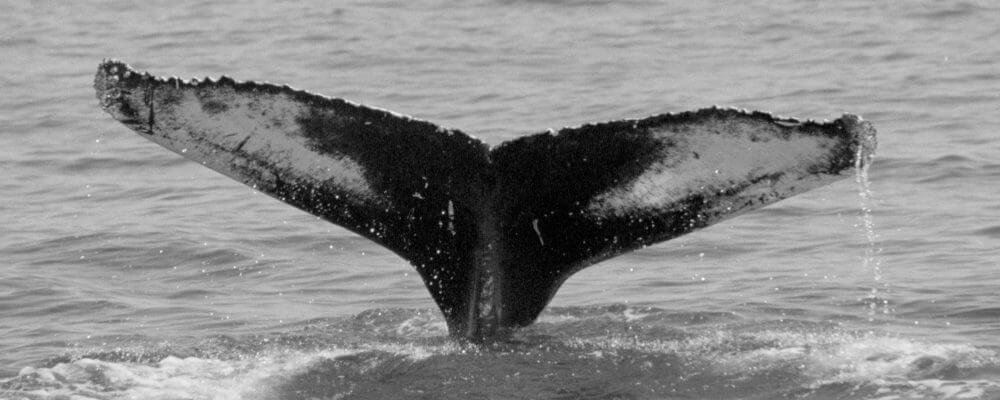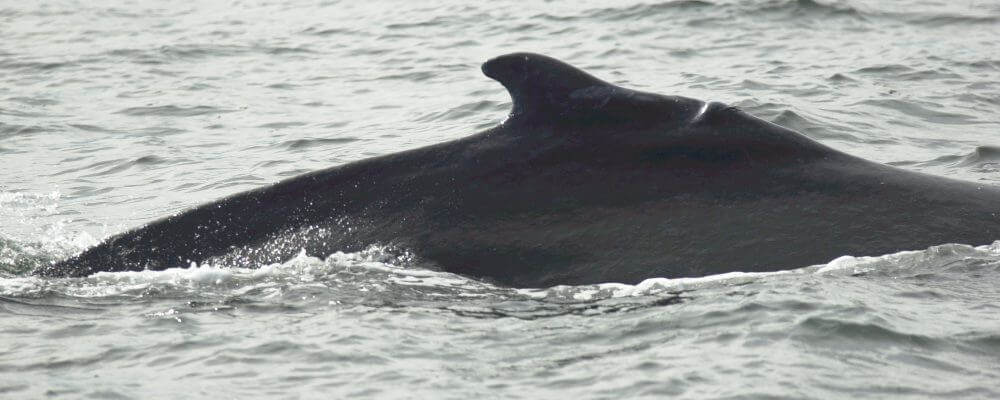Le Souffleur
Humpback Whale


-
ID number
H531
-
Sex
Female
-
Year of birth
Unknown
-
Known Since
1997
Distinctive traits
Le Souffleur can be identified by the unique coloration pattern under her caudal fin. She can also be distinguished from other humpback whales by the particular shape of her dorsal fin and by the scar she bears in front of it, on her hump.
Life history
In 2000, the cover of Le Souffleur, GREMM’s annual newsletter, featured a series of photos of a humpback whale that deployed its tail when diving. When a GREMM member recognized the same features on the tail of an animal he was watching on the river, he exclaimed, “It’s Le Souffleur!” and that’s how the female humpback whale H531 got her name. However, the team at the Mingan Island Research Station (MICS) calls her “La Souffleuse”.
Le Souffleur has been observed in the Mingan and Anticosti Islands area by MICS almost every year since 2002. In 2008, she was even accompanied by a calf. However, in the absence of a biopsy, it was impossible to establish their relationship. In 2017, Le Souffleur, which is also called La Souffleuse, was seen again with a small one.
With Tic Tac Toe, Le Souffleur was one of the first humpback whales to adopt the estuary for long stays in the late 1990s.
Observations history in the Estuary
Years in which the animal was not observed Years in which the animal was observed
Latest news from the publications Portrait de baleines
This humpback owes her funny name to a GREMM member who recognized this whale on the water, whose photo illustrated the front page of the organization’s annual magazine, entitled “Le Souffleur”. In the Gulf, this individual is known as “La Souffleuse”, which is consistent with the results of a biopsy carried out in 2002 by MICS indicating that it is a female! Since 2000, Le Souffleur has been identified almost every summer in the Gulf. She has been observed only three times in the marine park in the last 19 years. Thanks to observations made by MICS and GREMM, we know that Le Souffleur has already made a round trip from Tadoussac to Mingan in 2002, that is to say 1200 km, in less than 15 days! Among the presumed calves of H531, only the one of 2017 has been observed often enough in her company to be confirmed. Last February, Le Souffleur was seen with a small whale near the Turks and Caicos Islands, in the Caribbean. Could it be a 2021 calf? Finally, this small whale and Le Souffleur were observed more than 250 km apart and within a day of each other in July. This indicates that the whale first identified as the calf of H531 is actually a small adult whale! This story reminds us of the importance of observing the interactions and behaviours of two whales on several occasions before concluding that it is a mother accompanied by her calf.
Along with Tic Tac Toe, Le Souffleur was one of the first female humpback whales to visit the Estuary in the late 1990s. But her visits to the estuary stopped in 2003. We’re delighted to welcome her back this year! La Souffleuse, as she’s known in the Gulf, spent her last few summers in different areas: Gaspésie, Sept-Îles, the Mingan Islands… She had at least three calves. Her first, Tacho, has not been seen since 2011. Has he changed feeding grounds? H789 was only seen the year he was born. H879 was photographed in 2018, but unfortunately became entangled in Gaspé Bay. He has yet to be identified in 2019.
In 2000, the cover of Le Souffleur, GREMM’s annual newsletter, featured a series of photos of a humpback whale spreading its tail as it dived. When a GREMM member recognized the same features on the tail of an animal he was observing, he exclaimed “ it’s Le Souffleur!”, and the name has stuck ever since.
Her last visit to the estuary was in 2003, when she was seen on several occasions in the company of Tic Tac Toe. This week, on July 2 and 3, the same two humpback whales were spotted together! These two individuals are among the first humpback whales to have adopted the estuary for longer stays, in the late 1990s.
Humpback whales can be highly mobile within a single season, and can be identified in several regions of the St. Lawrence. Thanks to joint data from MICS and GREMM, a Tadoussac-Mingan round trip made by Le Souffleur had been traced: 1,200 kilometers in less than 15 days in 2002! Le Souffleur has been observed almost every year since 2002 by MICS in the Mingan-Anticosti area. In 2008, she was even accompanied by a calf… Yes, Le Souffleur is a female, just like Tic Tac Toe.
Le Souffleur can be recognized by the unique coloration pattern under her caudal fin. She can also be distinguished by the particular shape of her dorsal fin and by the scar it has just in front, on her humpback.
Le Souffleur, whose code name is H531, is one of some 700 “known” humpback whales in the catalog managed by MICS, which covers several regions of the St. Lawrence (Mingan-Anticosti, Sept-Îles, Gaspé-Percé, Blanc-Sablon, Basse-Côte-Nord and the Estuary).

